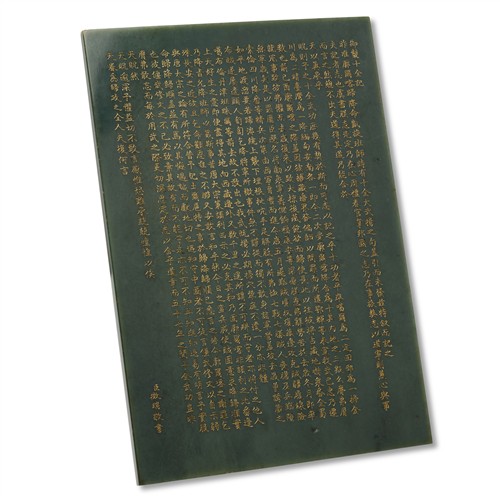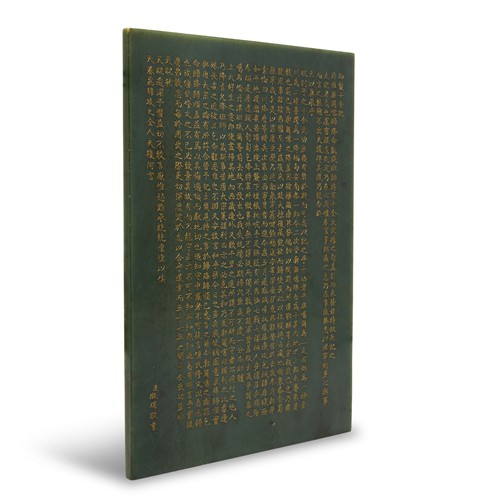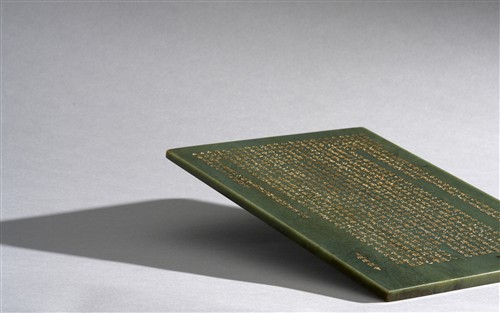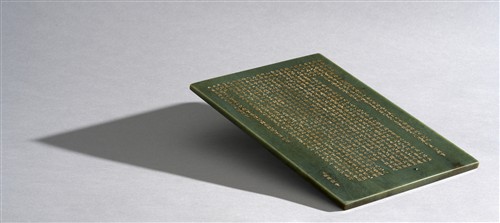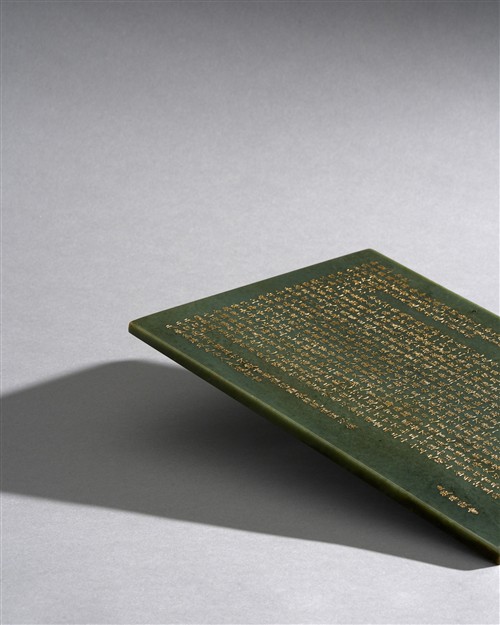Back
AN IMPERIAL CHINESE INCISED AND GILT SPINACH GREEN JADE "IMPERIALLY COMPOSED RECORD OF TEN COMPLETE VICTORIES" PLAQUE, QIANLONG PERIOD (1736 - 1795)
This jade plaque is made of Hetian green jade, inscribed with the full text of the Imperially Composed Record of Ten Complete Military Victories (Yuzhi Shiquan Ji), comprising a total of 724 characters. Each line contains thirty-seven characters, written in the formal Guange script style in meticulous, elegant calligraphy. The text is shallowly incised and then gilded. The carving is executed with extraordinary precision, using the center of the brush stroke to render the characters with smoothness and delicacy, as if written directly onto the jade with a brush. The gilding remains well preserved. At the end of the inscription is the colophon: "Respectfully written by your servant Zheng Rui." Based on its form, this jade plaque likely served as the central panel of a table screen.
The jade used is of substantial size and exceptional quality-fine, lustrous, and uniformly colored, free from cloudy inclusions or cracks. Even among the Qing palace collections of the Qianlong period preserved in the Palace Museum today, jade of such superior quality is exceedingly rare.
In the 24th year of Qianlong's reign (1759), one of the Emperor's most celebrated military achievements-the pacification of the Dzungars-was completed. As a result, Xinjiang, the source of Hetian jade, was brought under the direct control of the Qing government, and tribute jade from Hetian began to be sent in steady supply to Beijing. This provided Qianlong with new means to express his distinct aesthetic and imperial authority.
According to the Complete Archives of Qing Imperial Porcelain, Vol. 23, No. 72, a detailed inventory was recorded for Qianlong's 85th birthday in 1794 (the 59th year of his reign), listing the tribute offerings from various princes, ministers, and regional governors. Among the gifts submitted by Zheng Rui on the first day of the eighth lunar month is an entry for a "Pair of Table Screens Inlaid with Jade Inscribed with the Record of Ten Complete Victories." The jade screen offered in this auction is likely one of that very pair. According to archival notes indicating it was "sent to Rehe," it may have been lost overseas from the imperial summer retreat at Chengde (Rehe).
As for Zheng Rui, according to the Draft History of Qing - Biographies of Manchu and Han Officials, Vol. 24, he was of the Fuca clan, a Manchu of the Plain White Banner under the Imperial Household Department, and held in high regard by Emperor Qianlong (the Plain White Banner was one of the upper three banners directly under imperial command). In the 34th year of Qianlong's reign, he was appointed Superintendent of Yuanmingyuan Garden; in the 43rd year, he became Superintendent of Weaving in Hangzhou; and in the 48th year, Salt Commissioner of the Lianghuai region. These were all lucrative and powerful posts responsible for sourcing luxury goods for the imperial household.
With long-term oversight of key centers for the production of jade carvings and precious artifacts, such as Yangzhou, Suzhou, and Hangzhou, and enjoying ample wealth, Zheng Rui frequently presented opulent gifts to the emperor. In June of the 58th year of Qianlong's reign (August 1793), while serving as Salt Commissioner of Changlu and Imperial Envoy, Zheng Rui-together with the Governor-General of Zhili-received the famous British diplomatic mission led by Lord Macartney in Tianjin. Zheng Rui escorted the delegation to the Chengde Summer Resort, where they were granted an audience with the Emperor. He was also involved in multiple rounds of negotiation with the British concerning the court rituals expected for their audience with Qianlong. With the Emperor's final consent, the British envoy reluctantly performed a one-knee genuflection.
For an almost identical jade plaque, see Yongle Auction, Beijing, 20 June, 2024, lot 1774.
清乾隆 「御製十全記」碧玉填金刻文屏心
以和田碧玉製成,刻御製《十全記》全文,共724字,每行37字,以館閣體書寫,筆法工整,刻文淺浮並填金。 文末署「臣鄭瑞敬書」,推測此玉珮為屏風中央主板。此件玉質碩大,色澤潤澤均勻,無雜質或裂紋,品質極高。據《清宮瓷器檔案全集》第二十三冊第七十二號記載,乾隆五十九年(1794年)鄭瑞進獻「碧玉刻十全記屏風一對」。
鄭瑞為滿洲正白旗人,歷任圓明園總管、杭州織造、兩淮鹽政等要職
源流:
W.Y. Thomas Kwok 遺藏,1980年代初購於香港
28.6cm high; 19.6cm wide
Sold for $20,000
Lot 197
This jade plaque is made of Hetian green jade, inscribed with the full text of the Imperially Composed Record of Ten Complete Military Victories (Yuzhi Shiquan Ji), comprising a total of 724 characters. Each line contains thirty-seven characters, written in the formal Guange script style in meticulous, elegant calligraphy. The text is shallowly incised and then gilded. The carving is executed with extraordinary precision, using the center of the brush stroke to render the characters with smoothness and delicacy, as if written directly onto the jade with a brush. The gilding remains well preserved. At the end of the inscription is the colophon: "Respectfully written by your servant Zheng Rui." Based on its form, this jade plaque likely served as the central panel of a table screen.
The jade used is of substantial size and exceptional quality-fine, lustrous, and uniformly colored, free from cloudy inclusions or cracks. Even among the Qing palace collections of the Qianlong period preserved in the Palace Museum today, jade of such superior quality is exceedingly rare.
In the 24th year of Qianlong's reign (1759), one of the Emperor's most celebrated military achievements-the pacification of the Dzungars-was completed. As a result, Xinjiang, the source of Hetian jade, was brought under the direct control of the Qing government, and tribute jade from Hetian began to be sent in steady supply to Beijing. This provided Qianlong with new means to express his distinct aesthetic and imperial authority.
According to the Complete Archives of Qing Imperial Porcelain, Vol. 23, No. 72, a detailed inventory was recorded for Qianlong's 85th birthday in 1794 (the 59th year of his reign), listing the tribute offerings from various princes, ministers, and regional governors. Among the gifts submitted by Zheng Rui on the first day of the eighth lunar month is an entry for a "Pair of Table Screens Inlaid with Jade Inscribed with the Record of Ten Complete Victories." The jade screen offered in this auction is likely one of that very pair. According to archival notes indicating it was "sent to Rehe," it may have been lost overseas from the imperial summer retreat at Chengde (Rehe).
As for Zheng Rui, according to the Draft History of Qing - Biographies of Manchu and Han Officials, Vol. 24, he was of the Fuca clan, a Manchu of the Plain White Banner under the Imperial Household Department, and held in high regard by Emperor Qianlong (the Plain White Banner was one of the upper three banners directly under imperial command). In the 34th year of Qianlong's reign, he was appointed Superintendent of Yuanmingyuan Garden; in the 43rd year, he became Superintendent of Weaving in Hangzhou; and in the 48th year, Salt Commissioner of the Lianghuai region. These were all lucrative and powerful posts responsible for sourcing luxury goods for the imperial household.
With long-term oversight of key centers for the production of jade carvings and precious artifacts, such as Yangzhou, Suzhou, and Hangzhou, and enjoying ample wealth, Zheng Rui frequently presented opulent gifts to the emperor. In June of the 58th year of Qianlong's reign (August 1793), while serving as Salt Commissioner of Changlu and Imperial Envoy, Zheng Rui-together with the Governor-General of Zhili-received the famous British diplomatic mission led by Lord Macartney in Tianjin. Zheng Rui escorted the delegation to the Chengde Summer Resort, where they were granted an audience with the Emperor. He was also involved in multiple rounds of negotiation with the British concerning the court rituals expected for their audience with Qianlong. With the Emperor's final consent, the British envoy reluctantly performed a one-knee genuflection.
For an almost identical jade plaque, see Yongle Auction, Beijing, 20 June, 2024, lot 1774.
清乾隆 「御製十全記」碧玉填金刻文屏心
以和田碧玉製成,刻御製《十全記》全文,共724字,每行37字,以館閣體書寫,筆法工整,刻文淺浮並填金。 文末署「臣鄭瑞敬書」,推測此玉珮為屏風中央主板。此件玉質碩大,色澤潤澤均勻,無雜質或裂紋,品質極高。據《清宮瓷器檔案全集》第二十三冊第七十二號記載,乾隆五十九年(1794年)鄭瑞進獻「碧玉刻十全記屏風一對」。
鄭瑞為滿洲正白旗人,歷任圓明園總管、杭州織造、兩淮鹽政等要職
源流:
W.Y. Thomas Kwok 遺藏,1980年代初購於香港
28.6cm high; 19.6cm wide
Estimate $6,000 - $9,000
Overall in good condition.
CLICK TO SEE DETAIL PHOTOS OF THE WHOLE AUCTION
